Lexicon of the Hamas Organization
Nir Oz Massacre
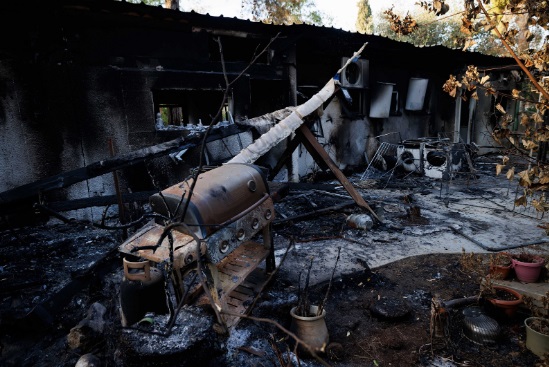
a burnt house in Nir Oz in October 7th. Credit: Kibbutz Nir Oz’s FB page.
Background History – Location, Community
The Nir Oz massacre occurred at the Nir Oz kibbutz in southern Israel. This community, known for its resilience and unity, became the epicenter of a horrific event that would mark one of the darkest days in the region’s history. The kibbutz, like many others in Israel, was a symbol of collective living and a testament to the enduring spirit of its residents.
The Assault on October 7th
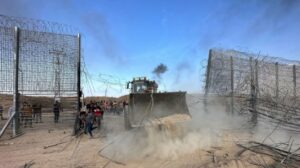
Palestinian tractor breaking through the border. Credit: Oz Koren’s FB page.
On October 7, 2023, Palestinian militants from the Gaza Strip executed a surprise attack on Israel, with Nir Oz Kibbutz being one of their primary targets. The attack was not just an isolated act of violence but part of a larger, coordinated assault across southern Israel, marking a significant escalation in the ongoing Israel-Arab conflict. The militants invaded the kibbutz, leading to widespread destruction and loss of life.
Death Toll and Casualties
The Nir Oz massacre resulted in the tragic loss of a significant portion of the kibbutz’s population. Out of approximately 400 residents, 180 were killed or abducted as hostages, according to The New York Times. The Jerusalem Post estimated about 80 abductions in Nir Oz alone. A veteran war correspondent reported that around a quarter of Nir Oz’s population was assassinated, kidnapped, or severely injured.
Evidence from Survivors
In the aftermath of the massacre, the survivors’ accounts painted a harrowing picture of the events. The kibbutz’s kindergarten and many homes were torched, leaving behind a scene of devastation. The surviving members of the kibbutz were evacuated to Eilat for safety. Among the casualties was the Kedem family, who were murdered in their secure room, including two 6-year-old daughters and a 4-year-old son. Additionally, among the hostages were notable figures like Polish-Israeli historian Alex Dancyg and a 12-year-old girl with autism, Noya Dan, along with her 80-year-old grandmother, Carmela Dan.
Conclusion
The Nir Oz massacre is a stark reminder of the fragility of peace and security in regions plagued by long-standing conflicts. The scale of the tragedy at Nir Oz underscores the human cost of the Israel-Arab conflict and highlights the urgent need for solutions that can bring enduring peace to the region. The stories of the survivors and the memories of the lost must continue to be part of the dialogue and efforts towards achieving a future where such tragedies are averted.
This article aims to provide valuable insights to readers seeking to understand the complexities of the Israel-Arab conflict and the impact of events like the Nir Oz massacre. By focusing on key aspects such as the background, the assault, the casualties, and the survivors’ accounts, it provides a comprehensive overview of this tragic event in recent history.
Lexicon of the Hamas Organization
The Ein Hashlosha Massacre
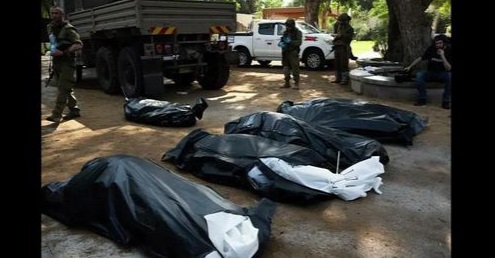
Hamas massacre’s victims. Credit: Gitay Armerman’s FB page.
Background History - Location, Community
Ein HaShlosha, a kibbutz in Israel’s western Negev desert, stands as a symbol of resilience and memory. Named after three founding members who perished in the 1948 Arab–Israeli War, this community was established in the 1950s by Zionist youth from South America, notably members of the HaNoar HaTzioni movement. Located near the Gaza border, Ein HaShlosha has faced significant challenges, including bombardments from the Egyptian army and being a target during various conflicts, notably the Gaza–Israel conflict in 2008. This proximity to conflict zones has exposed the community to frequent danger, including a tragic incident in 2008 when a volunteer from Ecuador that was killed by a Hamas sniper.
The Assault on October 7th
The Ein Hashlosha massacre on October 7, 2023, marked a harrowing escalation in the ongoing Israel-Hamas conflict. Hamas infiltrated the kibbutz, launching a brutal attack against its residents. This assault was part of the broader 2023 Israel–Hamas war, highlighting the ongoing tensions and the vulnerability of communities like Ein HaShlosha located near conflict zones.
Death Toll and Casualties
The Ein Hashlosha massacre led to a significant humanitarian crisis. Israeli forces, after three days of intense search and rescue operations, located 30 missing individuals from the kibbutz. This group, comprising 16 Israelis and 14 Thais, was found alive and well, a testament to the swift response and coordination among various Israeli security forces, including the military, police, and Shin Bet. The incident underscores the human cost of such conflicts and the deep scars they leave on communities.
Evidence from Survivors
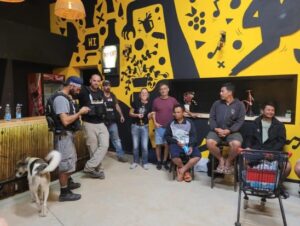
Survivors found in ein Hashlosha on Oct 10th. credit: Lital Peretz’s FB page.
Survivor accounts from the Ein Hashlosha massacre provide a harrowing perspective of the chaos and fear that gripped the community. As Hamas launched its terror attack, residents, in a desperate bid for safety, fled their homes and attempted to find refuge. This situation not only created a sense of panic but also highlighted the psychological trauma that such attacks inflict on civilians. The stories of these survivors serve as a powerful reminder of the human impact of conflict and the importance of striving for peace and security in the region.
The Ein Hashlosha massacre stands as a grim reminder of the volatility of the Israel-Hamas conflict. It underscores the urgent need for a sustainable solution that ensures the safety and security of all people in the region.
Lexicon of the Hamas Organization
The Battle of Sufa
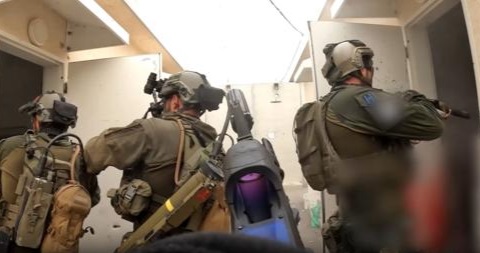
IDF’s Shayetet 13 force in Sufa. Credit: ‘YNET’ FB page.
Background History
The Battle of Sufa, which occurred on October 7, 2023, was a significant military engagement as part of Hamas’ Operation Al-Aqsa Flood. The village of Sufa, which borders the Gaza Strip, became the focal point of this conflict. It housed a military outpost manned by the Israel Defense Forces (IDF), in the Nahal Brigade’s Reconnaissance Unit, positioned only 3 kilometers from the border with the Gaza Strip.
Initial Ground Assault
The day began with a sudden and intense assault by Hamas on Israeli targets around the Gaza Strip, starting around 6 a.m. This operation included a barrage of rocket fire and a coordinated ground and air attack. The attackers initially faced resistance from a small group of armed civilians in Sufa, followed by the overtaking of the IDF outpost. The outpost’s Golani Brigade soldiers, caught off-guard, suffered casualties and some evaded capture by hiding inside a bunker.
Assault on the Outpost
In response, Israel’s elite Shayetet 13 unit, along with reservists, was rapidly deployed to the scene from their base in Atlit. Arriving by helicopter, these naval commandos engaged in heavy combat with the Hamas militants. Despite being significantly outnumbered, they managed to regain control of the outpost. Their intervention was crucial in turning the tide of the battle.
Shayetet 13’s involvement was pivotal, not only in combat but also in rescue operations. They coordinated with other IDF troops to rescue hostages and eliminate Hamas terrorists. In the midst of heavy fighting, they successfully eliminated more than 60 terrorists and rescued about 250 hostages. The battle saw some of Israel’s bravest, including Lt.-Col. Eli Ginzburg and First Sgt. Ofek Russo, lose their lives.
Evidence from Survivors
IDF’s Or Ben Yehuda. Credit: Diana Krayin’s FB page.
Survivor accounts highlight the intense and prolonged nature of the fighting. The Nahal Reconnaissance Unit engaged the terrorists for many hours, facing a situation of being outnumbered and nearly running out of ammunition. Reinforcements, including the Karakal Regiment led by Lt. Col. Or Ben-Yehuda and Shayetet 13, played a pivotal role in clearing the outpost of terrorists and rescuing hostages. The Shayetet 13 commandos were instrumental in saving some 250 hostages, including civilians and fellow soldiers.
The Battle of Sufa is remembered as a testament to the resilience and strategic capabilities of the IDF, particularly in the face of overwhelming odds. The success of the Shayetet 13 unit in rescuing hostages and eliminating the militant threat underlines the effectiveness of Israel’s military response to sudden and intense terrorist attacks.
Lexicon of the Hamas Organization
The Second Intifada
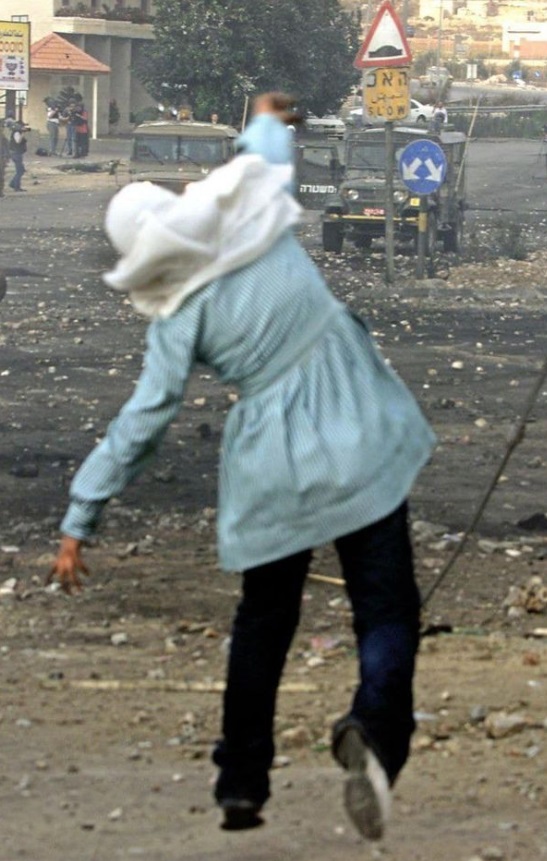
Second Intifada. Credit: Palestine ‘SunBird’ FB page.
The Second Intifada, also known as the Al-Aqsa Intifada, was a pivotal and intensely violent conflict in the Israeli-Palestinian history, spanning from 2000 to 2005. This comprehensive article delves into the background, timeline, impact on the Oslo Accords, and international involvement in this conflict.
Background
The Second Intifada emerged from a matrix of long-standing frustrations and immediate provocations. Key among these was the failure of the 2000 Camp David Summit, intended to achieve a final agreement in the Israeli-Palestinian peace process. The Oslo Accords, signed in 1993 and 1995, had set the stage for these talks. They included Israel’s commitment to withdrawing from parts of the Gaza Strip and West Bank and affirming Palestinian self-government in these areas. Conversely, the Palestine Liberation Organization recognized Israel and took responsibility for internal security in evacuated areas. However, the on-ground realities left both parties disillusioned.
Impact on the Oslo Accords
Oslo Accords Signing. Credit: ‘History In Pictures’ FB page.
The Second Intifada severely impacted the Oslo Accords. The Palestinians’ build-up of arms and security forces, in violation of the Accords’ terms, contributed to the breakdown of peace talks. The violence and distrust deepened, halting any progress toward peace and leaving both sides more entrenched in their positions.
International Involvement
Internationally, there were attempts to mediate peace, including the Arab Peace Initiative by the Arab League in 2002. This initiative proposed normalizing relations between Arab countries and Israel in exchange for a comprehensive peace agreement and the establishment of a Palestinian state. Despite wide support, this initiative was not implemented, and the conflict continues.
Context in Israeli – Arab Conflict
The Second Intifada is a defining moment in the Israeli-Palestinian conflict. It underscored the profound desperation and frustration of Palestinians and their commitment to fighting for freedom. Simultaneously, it highlighted the resilience of the Israeli state and its determination to maintain control over the Palestinian territories. The high death toll and the lack of significant progress towards resolution left a legacy of increased distrust and further complicated the Israeli-Palestinian relations.
Conclusion
The Second Intifada, with its deep roots in historical grievances and immediate triggers, not only resulted in significant loss of life and suffering but also marked a significant shift in the Israeli-Palestinian conflict. Its implications on the peace process, particularly the Oslo Accords, and the heightened international attention it drew, continue to shape the geopolitical dynamics in the region.
-
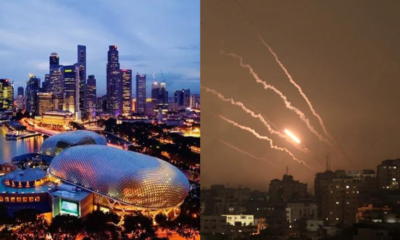
 News3 months ago
News3 months agoGaza could Have Been Singapore. Hamas Turned It Into a living nightmare
-

 News3 months ago
News3 months agoRape, slaughter, and atrocities—see the real face of Hamas
-
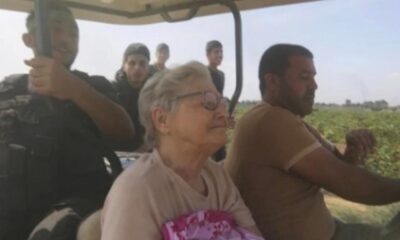
 News3 months ago
News3 months agoKidnapping elderly and children: Hamas are no heroes
-
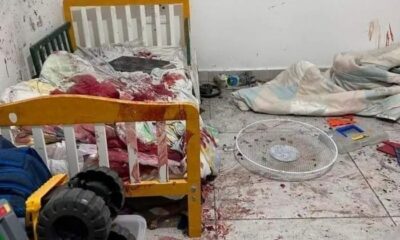
 News3 months ago
News3 months agoMonsters: Yahya Sinwar and Hamas kidnapped 150+ children and women.
-

 News3 months ago
News3 months agoTrigger warning: This is the atrocity that’s happening in Israel right now
-

 News3 months ago
News3 months agoShe died while saving lives.
-

 Hamas War Strategy, Tactics, and PR3 months ago
Hamas War Strategy, Tactics, and PR3 months agoThe War Crimes of Hamas and ISIS in Exploiting Civilians
-

 News3 months ago
News3 months agoHamas turns a music festival into a massacre






